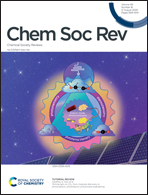Shining light on CO2: from materials discovery to photocatalyst, photoreactor and process engineering†
Abstract
Heterogeneous catalysis, a process in which the reaction of gaseous or liquid chemical reagents is facilitated at the surface of a solid material, is responsible for the majority of industrial-scale chemical and fuel production reactions. The energy required to drive these reactions has historically been derived from the combustion of non-renewable fossil fuels and carries an unavoidably large carbon footprint. More recently, the development of environmentally responsible and sustainable chemical industries is increasingly motivated by greenhouse gas-induced climate change, thus creating demand for eco-friendly heterogeneous catalytic processes. This includes innovative approaches enabled by renewable forms of energy, such as the electrification of chemical and petrochemical processes, utilization of CO2 as a feedstock and the incorporation of light into catalytic reactions. Herein we review the conversion of solar energy to chemical energy using CO2, and describe how the photophysical and photochemical properties of nanostructured metal oxide photocatalysts have been engineered to efficiently incorporate light into heterogeneous gas–solid CO2 hydrogenation reactions. Realizing high photonic and energy efficiencies in these systems has demanded innovation in not only photocatalyst engineering, but also photoreactor and process engineering. Rather than exclusively providing an in-depth discussion of the chemistry and science within each individual study, this Tutorial Review highlights the multidisciplinary character of photocatalysis studies by covering the four essential components of a typical research work in this field (materials engineering, theoretical modelling, reactor engineering and process development) via case studies of the archetypal indium oxide catalyst materials. Through advances in these four components, progress has been made towards the ultimate goal of industrializing the production of CO2-derived chemicals and fuels.



 Please wait while we load your content...
Please wait while we load your content...